General Gear Information
Differences between the ESP LTD Lynch 500 series and 200 series guitars
A quick comparison of the 500 vs 200 series guitars of the same models (Kamikaze and Tiger). I took some photos to describe the differences and measured the neck widths, using a caliper. I knew that the 500 series Kamikaze's neck felt wider, so I started there. Although the differences seem small when you look at the numbers, it's significantly wider when you feel it in your hands.
Kamikaze:
200: 2.059" (52.2986 mm)
500: 2.254" (57.2516 mm)
Tiger:
200: 1.989" (50.5206 mm)
500: 2.101" (53.3654 mm)
Front
Here are the Kamikaze 200 and 500 side by side: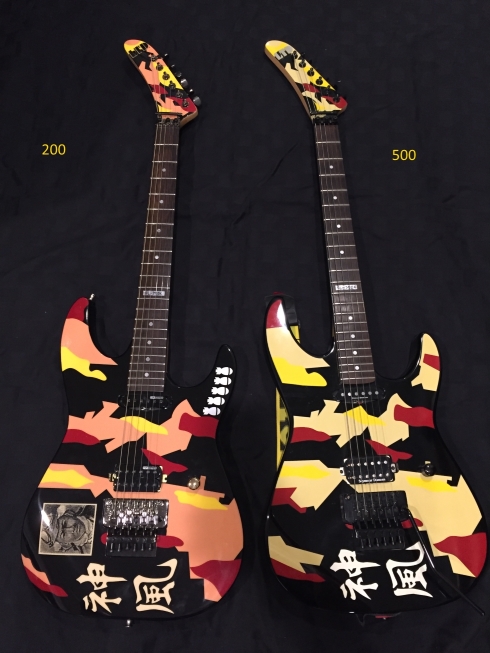
As you can see, the 500 is missing the Kamikaze pilot and the bombs, that were on the original. But the colors are the same as the original mode. Since the 500 has the same materials, they probably wanted to be able to distinguish them from the original. The 200 series colors are more beige, on both the body and neck. The 500 hardware is black. 200 is chrome. The pickups on the 500 are Duncan Designed (although the one in the photo have been changed to a Duncan JB), which are designed by Seymour Duncan, but are manufactured overseas. They try to match the original sound. The 200 series comes with ESP Designed pickups, which do not mimic the original sound.
The headstock logo is different. The LTD logo on top of the 500 is silver, the 200 is black with gold outline.
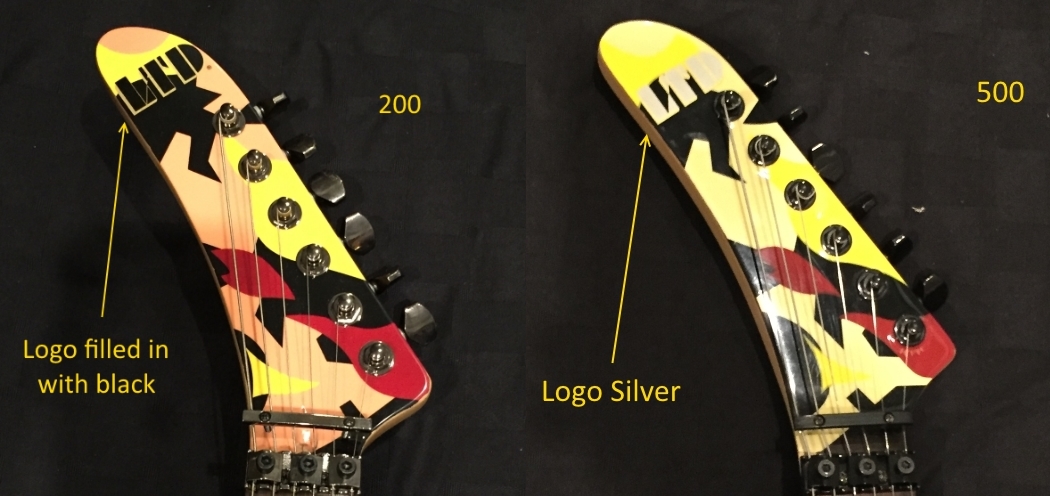
The Neck contour, near the headstock is different. The 500's contour is rounder, and the 200 is bulkier. Will you really notice it? Probably not, but it's there.
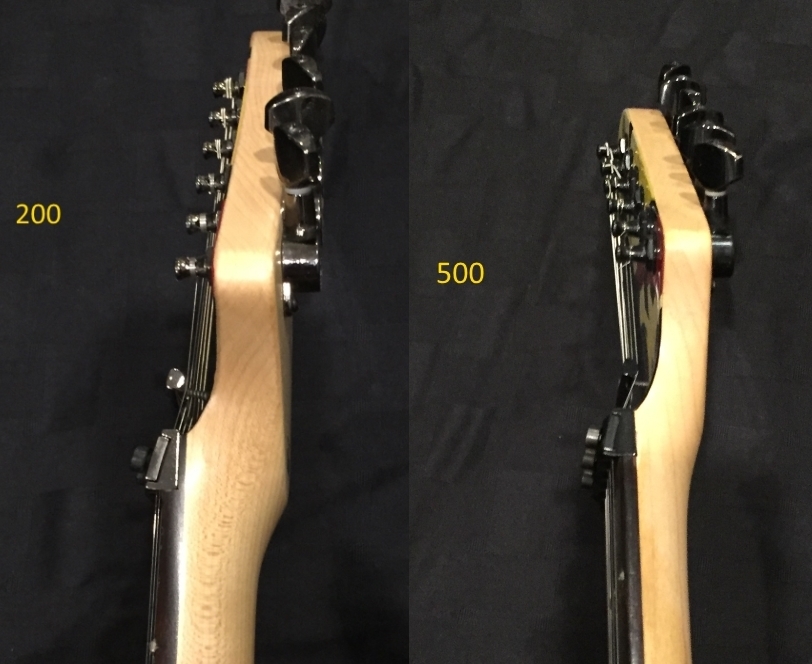
Back
The back is where you can see a big difference: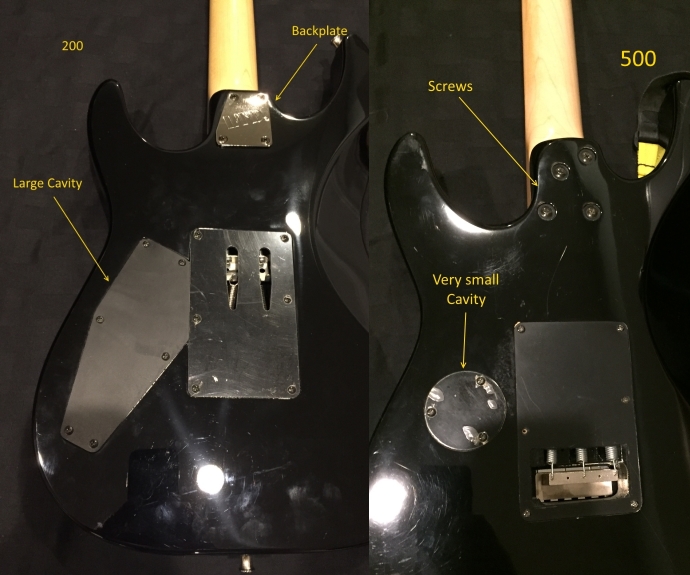
The 200 has a back plate, and a large cavity for the wiring and pot. This is probably due to the wood used. They used a softer wood on the 200.
The 500 is made of maple, which is hard. So there is no need for a backplate. Also, the wiring access is very small.
The tigers are also different.
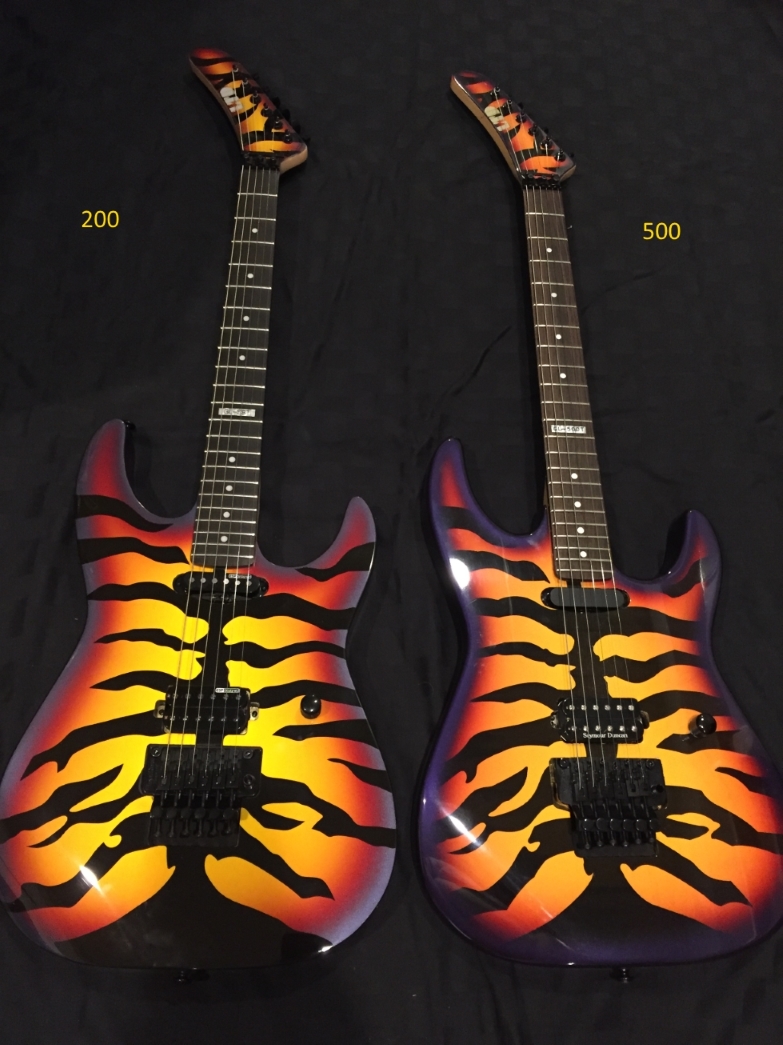
There are some major differences in the color, and how it was painted. The 500 is darker, mainly because the black tiger stripes are bigger. Also, there is more red/orange on the headstock.
One thing that I wasn't aware of before, was that the paint jobs were done differently. First, the purple on the 500 is much deeper and richer, than the 200. If you look at the 200, you can see that the black was the last color painted. It overlaps the out ring of purple. On the 500, the purple was the last color painted, which gives it a better look (in my opinion).
The backs of the two models are very different:
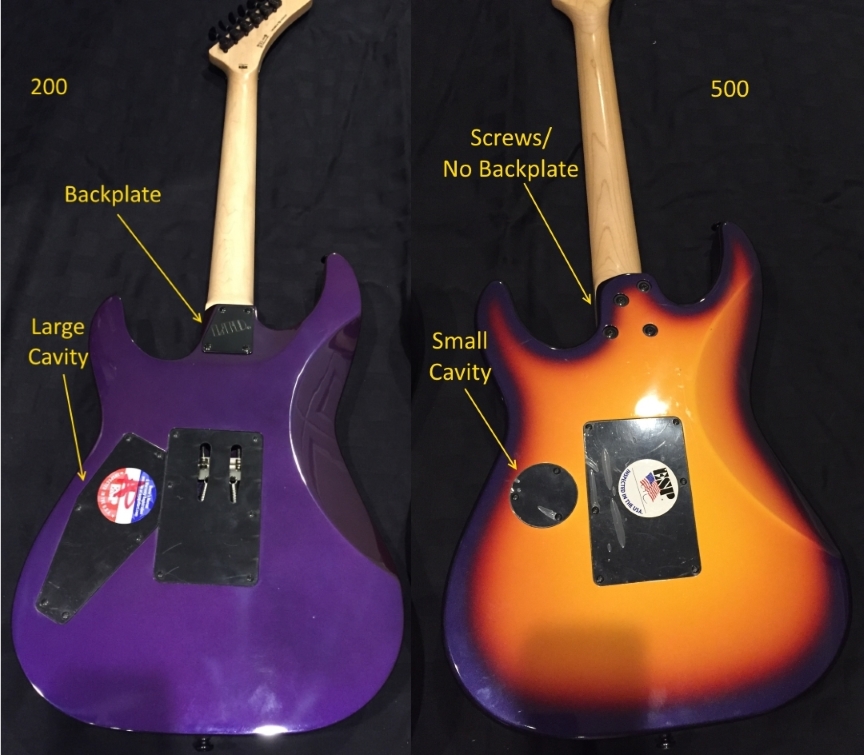
The obvious difference is the paint job. The 500 follows the coloring of the front of the guitar.
Just like the Kamikaze, the 200 has a backplate and large cavity. The 500 has no backplate and a small cavity.
Truss rod access
Another HUGE difference in the 2 guitars is the truss rod access location. On the 200 series, the truss rod access is on the headstock. If you look at the headstock, you can see a truss rod cavity near the nut. On the 500 series, the truss rod access is on the heal of the guitar, which means you have to loosen the neck screws to access it. The added benefit is there is no headstock cavity, and the nut to headstock area looks beautiful.The truss rod in the heal can be a pain for novice users, but it's really not hard to do at all. You can see how to adjust the truss rod on the guitar maintenance page in the menu.
As I stated above, the 500 copies the actual George Lynch ESP guitar, where the 200 series differs in certain areas.
Wrap up
There are many differences between the 2 models. The 500's are becoming harder and harder to find, since they are no longer produced.This comparison is not to say that the 200 series is not a good guitar, because it is a good guitar, but there are some major differences between to the 200 and 500 series guitars.
Tube vs Solid State Power Amp (An unscientific test)
I know this is probably a controversial topic, but these are my findings when comparing solid state power amp to a tube power amp.
I have been absolutely loving my Synergy SYN-1, which is a tube pre amp that handles pre amp modules from different manufacturers. I mostly play it through my Seymour Duncan PowerStage into a cabinet. It sounds fantastic. but, I started thinking about how it would sound through a tube power amp. The good news is that the SYN-1 can be used through a head's FX Loop, and completely take over the head. You can use the head preamp, or bypass the amps preamp, and use the SYN-1 as the preamp via the SYN-1's footswitch.
I set up a Shure SM57 and recorded a track with the SYN-1 through a 5150 head with EL34 power tubes. I then changed the setup, and simply went through the Duncan PowerStage. They sounded damn close to my ears.
I then checked the EQ of each of the tracks using Ozone. I set the Ozone EQ points to each of the points on my MXR 10-band EQ. To my amazement, there was very little difference, less than 1db, on each of the points.
MXR EQ Settings to match the PowerStage to the EL34s
62.50: +0.5db
125: -1.0db
250: -2.0db
500: +0.5db
1000: +0.5db
2000: +0.5db
4000: +0.5db
8000: +0.25db
16000: +0.25db
Here is a picture of both EQ lines for comparison.
White: EL34
Yellow: PowerStage
EL34(white)Comparison.jpeg)
Synopsis:
This is far from scientific, but this confirms that I don't necessarily need to use a tube power amp. It's extremely close, and the minimal difference is just that....minimal. I'll be doing more tests, but this opened my eyes to the fact that tube purists (in this unscientific test) can keep their tube amps, and I'll stick with my SD PowerStage.
Not Your Father's Celestion Vintage 30s
So, I gave up, and played through the cabinet as it was for the last 2 years, fairly regularly. I also made many Kemper profiles with it, over that period, at ridiculously loud levels (and in-ears with my old work noise protection headphones over them).
I know that nothing is going to age them besides age and use, but I compared some of the profiles that I made 2 years ago with a couple I made recently, and they were pretty much identical. So, the speakers aren't "aging" at all. I had no idea what it could be. I tried putting the speakers in another 4X12 cabinet, and that wasn't it. I eventually gave up.
I watched a video of a producer who was basically doing the same thing, and he came to the conclusion that the Chinese Vintage 30s, do not sound like the UK Vintage 30s. So, I started looking for an older cabinet with UK Vintage 30s.
I found one, a stock Carvin 412v-30 with 4 UK Celestion Vintage 30s. I plugged it in and gave it a shot. THERE WAS THE SOUND!!!
I wasn't sure that it really sounded different, or was it just that I "wanted" it to sound different.
I recorded a DI track, then reamped that track into my Friedman BB at 555. I matched up where to put the SM57, and taped a small square area to make sure they were in the correct place. After recording each cabinet with the same settings, I ran an EQ Tone Match to see what is different.
The EQ Tone Match takes the target track (UK V30s), and then checks the source track that you want to sound like the target. It then makes an EQ that will allow the source track to sound like the target track.
Here is the difference that I found.
EQ Tone Match
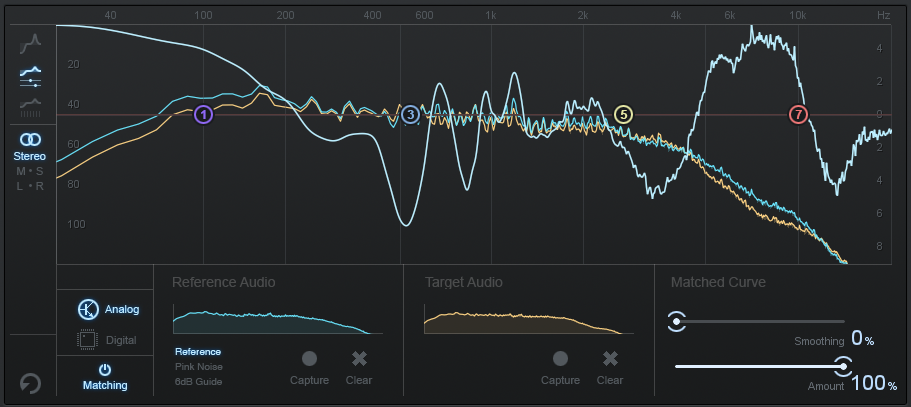
The blue and yellow are the target and source EQ profiles. The white shows the differences in them.
Zoomed In

Conclusion
The conclusion that I found was that, although they are both labeled Celestion Vintage 30s, but the Chinese V30s are different speakers than the UK V30s. They probably should have named them something else (V30c). If you buy a new V30 (from China), you're probably expecting the classic sound, which use UK Vintage 30s. Unfortunately, that's not what you're getting.I'm not saying that they sound bad. I'm saying they are voiced differently than the UK V30s.